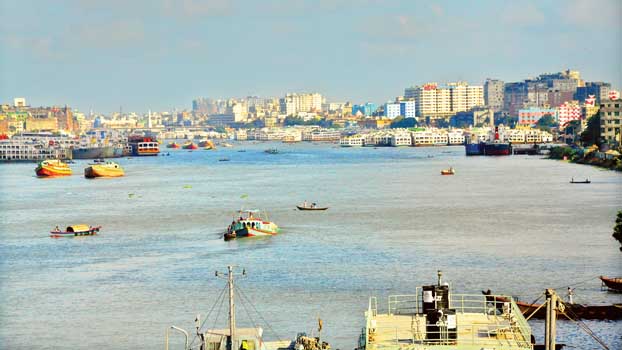Buriganga to get back 1926 look


- 7.5 kms of Buriganga river to be restored; 15-km road to be built on both sides.
- There will be beautiful greenery, recreation spots on the banks
The government has taken a mega plan to restore the previous appearance of the Buriganga, once the mighty river.
The plans aim to bring back the look, the river had in 1926, according to the cadastral survey map.
Dhaka South City Corporation (DSCC) has taken an initiative to restore about 7.5 kilometers of the river area, which has been occupied either by grabbing or through filling.
DSCC mayor Barrister Sheikh Fazle Noor Taposh said the initiative has been taken as per the directive of Prime Minister Sheikh Hasina.
If the project is implemented by reviving the original channel of the Buriganga [according to the CS map from 1926 to 1940], the appearance of the riverside area from Islambagh to Rayerbazar will change radically.
Apart from restoring the occupied river land, about 15-kilometer road will be built on the both sides of the river and the area will be mordenised and given a facelift like Hatirjheel, DSCC sources said. While talking about the beautification of the riverbanks, the mayor told the media, “We have taken initiative to restore the original Buriganga channel. Military Institute of Science and Technology (MIST) has been appointed as a consultancy firm here. The MIST has already submitted a preliminary report and we are working on that report.”
According to the draft proposal of the MIST, beautiful greenery, open space and recreation spots will be created on both sides of the river. At the same time, adequate number of bridges or overpasses will be constructed to maintain communications with both the sides of the channel.
The city-dwellers of a large part of the capital city will get rid of waterlogging problem to a great extent through the restoration of the entire channel, the draft proposal reads.
The life style of the people living on both the sides of the river including Kamrangirchar, Islambagh, Lalbagh and Hazaribagh will also change.
The estimated cost of the project has been estimated at Tk 6000 crore.
Meanwhile, Rajdhani Unnayan Kartripakkha (RAJUK) has also proposed to restore the original channel of the Buriganga in Detailed Area Plan (DAP).
DAP Project Director Ashraful Islam told Bangladesh Post, “Many river areas have been occupied through filling. The revised DAP has recommended to restore the original channel of the Buriganga. RAJUK will provide all kinds of assistance to the implementation of the DSCC’s initiative.”
However, many people think that it is not easy to bring back the Buriganga to what it looked like almost 100 years ago.
According to them, influential quarters have occupied the original channel of the Buriganga and constructed various institutions.
With the help of corrupt officials of the administration, many influential quarters have forged the documents of the river-land in their own name while many occupiers have built permanent infrastructures in place of the original channel.
The project implementation authorities also think that the work will be very challenging.
DSCC Executive Engineer Md Khairul Baker, an engineer of the project, told Bangladesh Post, “The project will cover three times more area than Hatirjheel. So the work is quite difficult to implement. There areas are almost completely occupied. But Hatirjheel was unoccupied. There are more challenges to face in the implementation of the project.”
He also said, “The mayor instructed to mark the boundaries of the river following the CS map. Currently, the work is underway to mark the river boundary. DSCC wants to implement the work in a more planned manner than it was done at Hatirjheel in the shortest possible time.”
About the project, General Secretary of Bangladesh Institute of Planners (BIP), Dr Adil Mohammad Khan, told Bangladesh Post, “This initiative needed to be taken earlier. If this project is implemented, the waterlogging problem of a large part of Dhaka will be solved.”
“We have to make the capital clean and develop step by step. Other canals and drainage channels of the capital need to be restored. Then the waterlogging problem of the capital will be solved,” he added.
The Buriganga River, which was once the lifeline of the capital Dhaka, carries huge economic and political importance for the country with launches providing connection between the capital and other parts of Bangladesh.
When the Mughals made Dhaka their capital in 1610, the banks of the Buriganga were already a prime location for trade and subsequently the business activities of the capital expanded surrounding the river.
But mindless discharge of industrial and household waste over last several decades has made the river a narrow channel of water and one of the most polluted rivers in the country.
The government, however, has taken the mega plan to restore its previous look and size in an effort to bring back its lost glory.
The chemical waste of mills and factories, household waste, medical waste, sewage, dead animals, plastics, and oil are some of the Buriganga's pollutants.
According to Department of Environment, Dhaka city discharges about 4,500 tonnes of solid waste every day and most of it is released into the Buriganga.
According to the department, 5.7 million US gallons of toxic waste are released into the river by the tanneries every day.
Experts identified nine industrial areas in and around the capital city as the primary sources of river pollution: Tongi, Tejgaon, Hazaribagh, Tarabo, Narayanganj, Savar, Gazipur, Dhaka Export Processing Zone and Ghorashal.
The Buriganga flows past the southwest outskirts of capital Dhaka. Its average depth is 25 feet while the maximum depth is 58 feet.


